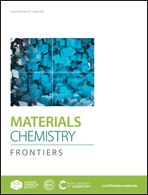A tris-tetrazole based nanostructured soft material: studies on self-healing, AIEE, and rheological and fluorometric detection of 3-aminopyridine†
Abstract
The tetrazole based gelator molecule N2,N4,N6-tri(1H-tetrazol-5-yl)-1,3,5-triazine-2,4,6-triamine (G8) has been synthesized and characterized using ESI-MS, NMR and FTIR techniques. G8 itself formed an organogel which shows aggregation induced enhanced emission (AIEE). It also shows fluorescence in the concentrated solution state due to the intramolecular charge transfer (ICT) within the planar structure of the compound. To analyse the possibility of discrimination between various isomers of the organic compound depending upon their hydrogen bonding sites G8 is used to interact with the isomers of aminopyridine (AP) and three mixed organogels, viz.G8-2AP, G8-3AP and G8-4AP. The interactions of the isomers of aminopyridines and the predicted structures of G8-2AP, G8-3AP and G8-4AP have been investigated by fluorescence, 1H NMR, PXRD, FT-IR and DFT studies. Of these three aminopyridines, G8 shows selective sensing of 3-AP with notable changes in terms of fluorescence mostly due to the stronger restriction of intramolecular rotation (RIR) within the G8 molecule, thus blocking the non-radiative pathway. 3-AP also gets recognized by a higher storage modulus as compared to the other organogels due to the formation of stronger hydrogen bonds (N–H⋯N) within G8 and 3-AP molecules. Furthermore, G8 can also distinguish 3-AP by visual colour changes with respect to other aminopyridines. The morphological study of the gels and xerogels has been done by FE-SEM analysis and it was found that the synthesized organogels have nanostructured morphology. These morphological studies also indicate the 3-D changes in the structure from organogel G8 to organogels of isomers of aminopyridine with G8. The thermal study has been done via thermogravimetric analysis (TGA) which shows the slow combustion of the xerogels of organogels as compared to gelator molecule G8 due to the formation of a higher number of non-covalent interactions inside gel networks. Moreover, all the organogels show self-healing behavior which has been confirmed by the physical and time oscillation sweep (TOS) experiment, showing that the thixotropic behavior of G8-3AP decreases with increasing number of cycles due to the greater storage modulus value of G8-3AP. The selective results due to the interaction of the isomers of aminopyridine with G8 confirm the effect of the isomeric position on the different properties of the mixed organogels.

- This article is part of the themed collection: FOCUS: Recent progress on aggregation-induced emission


 Please wait while we load your content...
Please wait while we load your content...